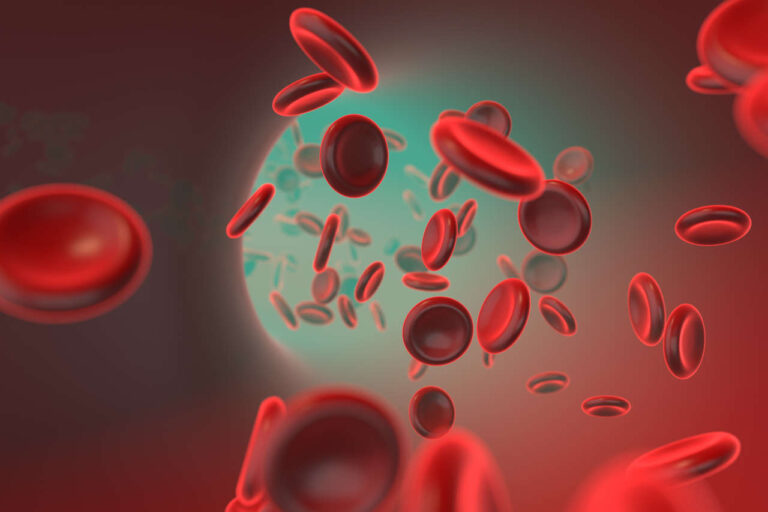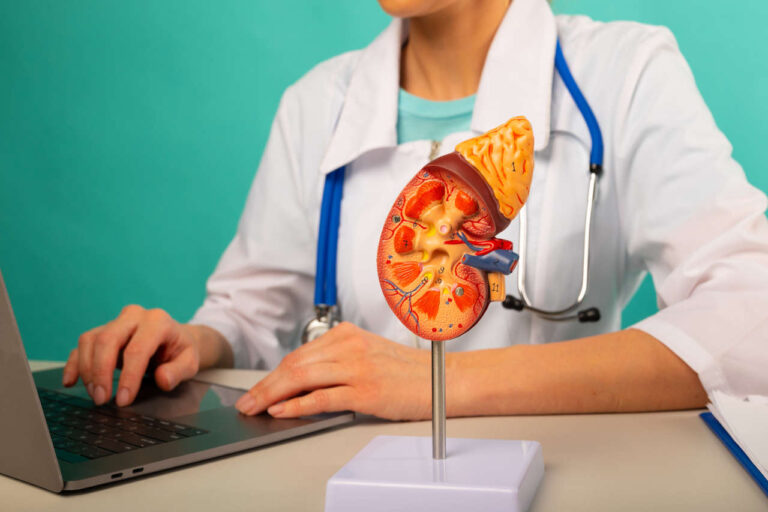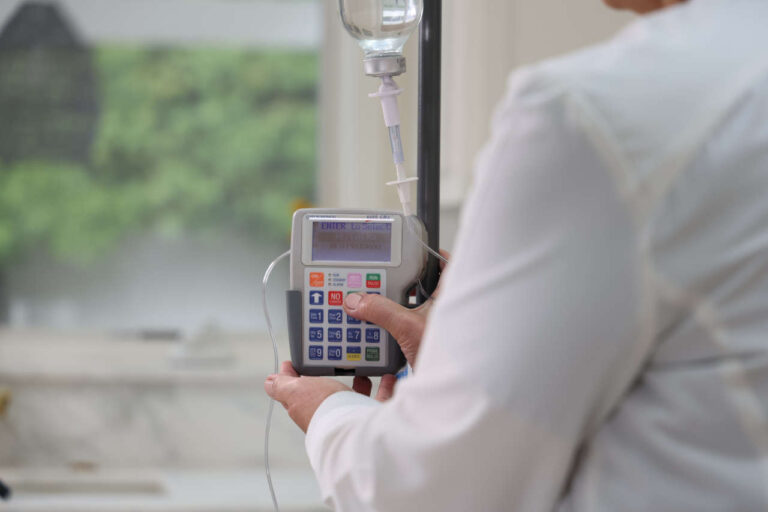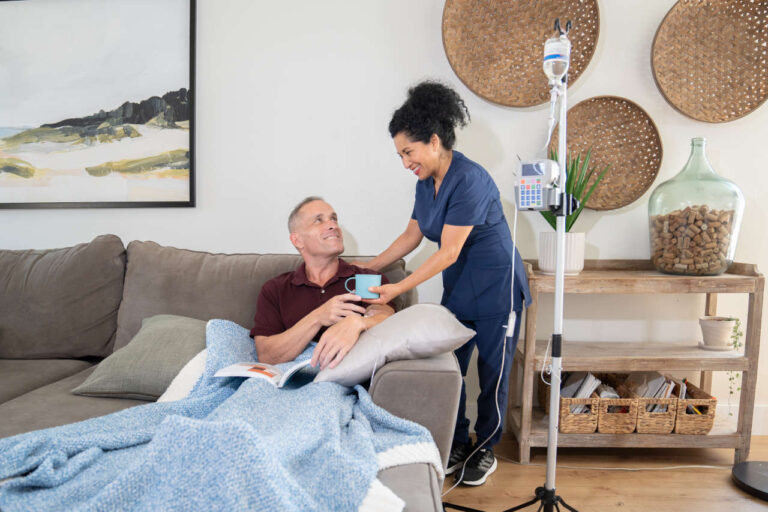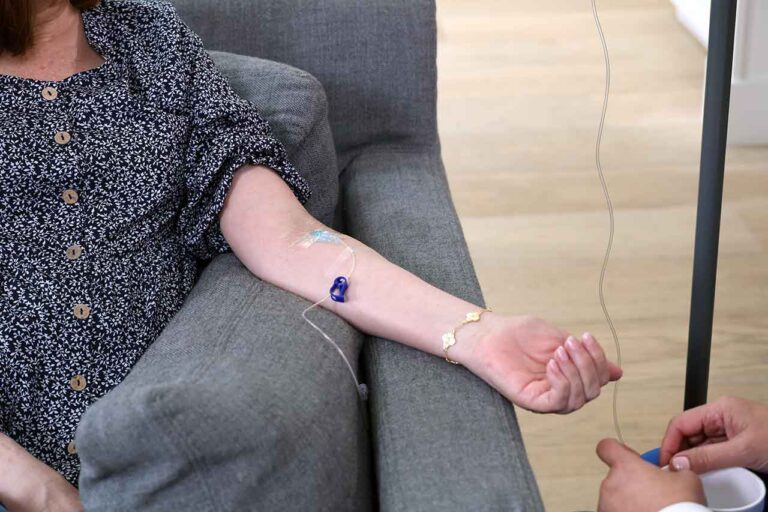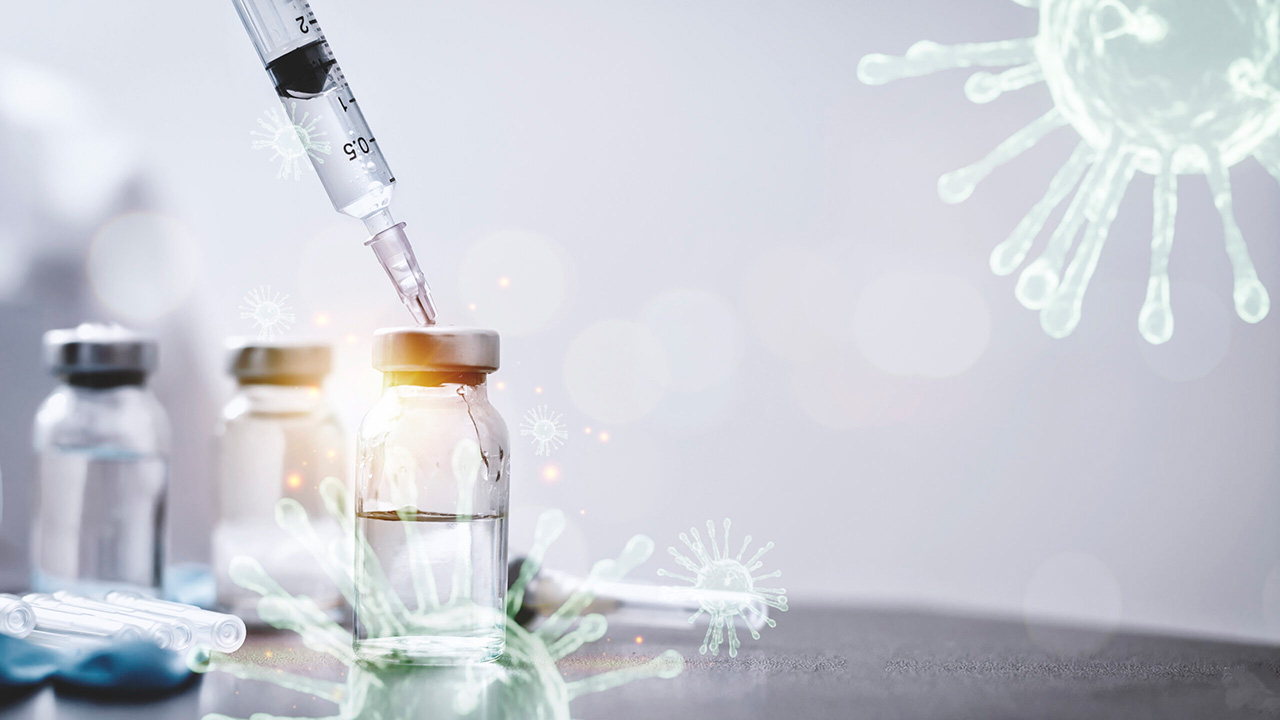
Xembify este un tip de imunoglobulină subcutanată (SCIG). Conține un spectru larg de anticorpi (imunoglobuline) extrase dintr-o cantitate mare de plasmă umană.
Xembify is a 20% immune globulin solution that is FDA indicated for primary humoral immunodeficiency and can be used in a number of other medical conditions.
Get Your Xembify Dose
Vorbește cu un specialistWhat Is Inside Xembify?
Xembify is a non-pyrogenic ready-to-use sterile product. The solution contains IgG (18-22% protein) present in 0.16 M to 0.26 M glycine and around 10 – 40 mcg/ml polysorbate.
Xembify does not contain any preservatives and is not made with rubber latex.
What Does It Look Like?
Xembify is colorless to a pale yellow solution that is almost clear or slightly opalescent.
Cum funcționează Xembify?
Xembify oferă o varietate de imunoglobuline (Ig) care sunt de natură opsonizantă (mai ușor de distrus) și neutralizantă. Bacteriile, virusurile, paraziții și agenții micoplasmici, precum și toxinele pe care le eliberează, sunt neutralizate de anticorpii găsiți în Xembify.
Asistență pentru coplată Xembify
Xembify Storage
Xembify is stored refrigerated (2 – 8 degrees Celsius). It can also be stored at room temperature for up to 6 months, any time prior to the expiration date. Do not freeze.
If refrigerated, let Xembify come to room temperature before use. Do not microwave.
Treatment/Therapy
Xembify este indicat de FDA pentru imunodeficiența umorală primară la pacienții cu vârsta de 2 ani și peste. Aceasta include, dar fără a se limita la, agamaglobulinemia congenitală, imunodeficiența variabilă comună (CVID), agamaglobulinemia legată de cromozomul X, sindromul Wiskott-Aldrich și imunodeficiențele combinate severe.
Imunodeficiența umorală primară (IP)
Funcția suboptimală a sistemului imunitar într-un imunodeficiența umorală primară pacientului poate fi dăunător. Tratamentul cu Xembify poate întări considerabil sistemul imunitar și poate îmbunătăți calitatea vieții.
Contraindications
Although Xembify has a wide window of tolerance and acceptance, there still are some cases where Xembify administration is contraindicated. Some of these conditions are mentioned below.
Allergic Reaction
Xembify must not be given to candidates who have had an anaphylactic or severe allergic reaction to human immune globulins. The major manifestations of this hypersensitive reaction include:
- Dificultăți de respirație
- Swelling in the neck area
- Severe skin rash
- Acrocyanosis (extremities turning blue)
You should seek medical attention immediately if the symptoms mentioned above start appearing.
If you have experienced such issues previously with IVIG, then you must not use Xembify.
IgA Deficiency
You should stay away from Xembify or any other immunoglobulin infusion if you are IgA deficient. This is because IgA deficient people usually develop anti-IgA antibodies. Therefore, the body responds via a hypersensitivity reaction, which can sometimes be fatal.
Subcutaneous Infusion
Unlike IVIG therapies, which are given intravenously, Xembify is given by subcutaneous route only.
Dosage
Farmacocinetica și răspunsul clinic al pacientului determină doza de Xembify. Următoarea secvență este adoptată pentru a determina cantitatea corectă.
- După inițierea tratamentului cu Xembify, măsurați nivelul seric minim de IgG al pacientului încă de la 5 săptămâni.
- Continuați monitorizarea nivelului minim de IgG la fiecare 2 până la 3 luni pentru a determina dacă sunt necesare ajustări ulterioare ale dozei.
- Pentru doze frecvente (de două până la șapte ori pe săptămână), împărțiți doza săptămânală calculată la numărul dorit de perfuzii pe săptămână.
Nota: If a patient does not maintain adequate clinical response to Xembify therapy (or serum IgG level is not achieved to the level of a previous treatment), dose adjustments may be necessary. For dose adjustments, the doctor will calculate the difference between the IgG trough level from the target IgG trough level, then find the difference via the following table:
Dose Adjustment (Ml per Week)
| Diferența față de nivelul minim țintă al IgG (mg/dl) | 10 kg | 15 kg | 20 kg | 30 kg | 40 kg | 50 kg | 60 kg | 70 kg | 80 kg | 90 kg | 100 kg | 110 kg | 120 kg |
|---|---|---|---|---|---|---|---|---|---|---|---|---|---|
| 50 | 0 | 1 | 1 | 1 | 2 | 2 | 2 | 3 | 3 | 3 | 4 | 4 | 5 |
| 100 | 1 | 1 | 2 | 2 | 3 | 4 | 5 | 5 | 6 | 7 | 8 | 8 | 9 |
| 150 | 1 | 2 | 2 | 3 | 5 | 6 | 7 | 8 | 9 | 10 | 11 | 13 | 14 |
| 200 | 2 | 2 | 3 | 5 | 6 | 8 | 9 | 11 | 12 | 14 | 15 | 17 | 18 |
| 250 | 2 | 3 | 4 | 6 | 8 | 9 | 11 | 13 | 15 | 17 | 19 | 21 | 23 |
| 300 | 2 | 3 | 5 | 7 | 9 | 11 | 13 | 16 | 18 | 20 | 23 | 25 | 27 |
| 350 | 3 | 4 | 5 | 8 | 11 | 13 | 16 | 19 | 21 | 24 | 27 | 29 | 32 |
| 400 | 3 | 5 | 6 | 9 | 12 | 15 | 18 | 21 | 24 | 27 | 30 | 33 | 36 |
| 450 | 3 | 5 | 7 | 10 | 14 | 17 | 20 | 24 | 27 | 31 | 34 | 38 | 41 |
| 500 | 4 | 6 | 8 | 11 | 15 | 19 | 23 | 27 | 30 | 34 | 38 | 42 | 45 |
Localizați cantitatea corespunzătoare (în ml) cu care să creșteți/scădeți doza săptămânală, în funcție de greutatea corporală a pacientului.
Exemplu: If a patient with a body weight of 70 kg has an IgG trough level of 900 mg/dl and the target level is 1000mg/dl, the difference is 100mg/dl. Thus, increase the weekly dose by 5 ml.
Safe Xembify Administration
Get Prior Authorization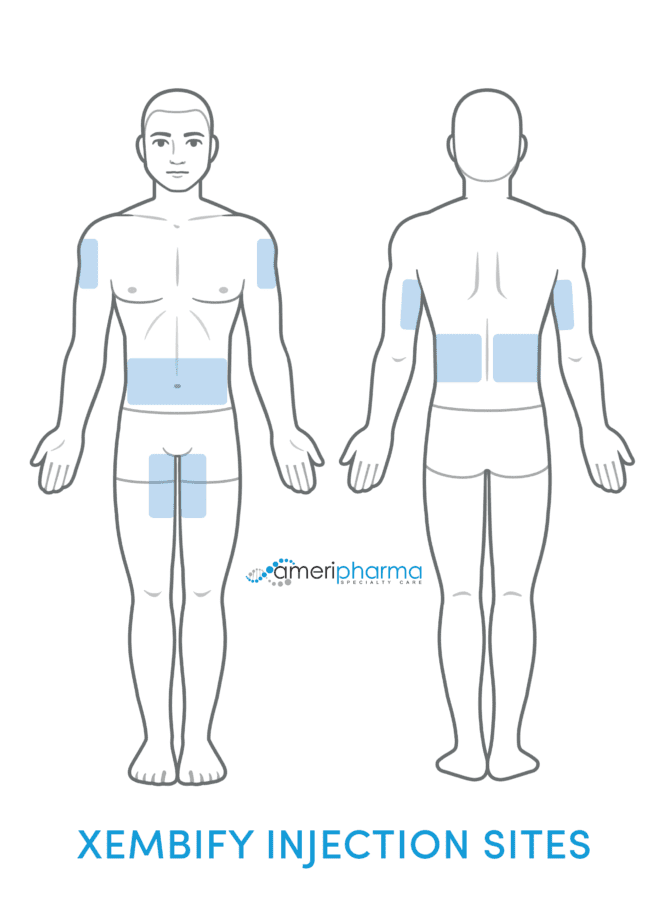
Precauții
Pregnancy
No human data is available to indicate the presence or absence of drug-associated risk. Animal reproduction studies have not been conducted with Xembify. It is not known whether it can cause fetal harm when administered to a pregnant woman or if it can affect reproduction capacity.
Lactating Mothers
No human data is available to indicate the presence or absence of drug-associated risk. The developmental and health benefits of breastfeeding should be considered along with the mother’s clinical need for Xembify and any potential adverse effects on the breastfed infant.
Pediatric Use
Xembify was evaluated in 14 pediatric subjects (2 – 16 years of age) with PI in a multi-center clinical trial. The safety and efficacy profiles were similar to adult subjects. No pediatric-specific dose requirements were necessary to achieve the desired serum IgG levels. The safety and effectiveness of Xembify in pediatric patients below 2 years of age have not been established.
Geriatric Use
Clinical studies of Xembify did not include sufficient numbers of subjects over age 65 to determine whether they respond differently from younger subjects. Three study subjects enrolled in the clinical trial were 65 years and older. In general, dose selection for an elderly patient should be made cautiously, usually starting at the low end of the dosing range.
Cost
The cost of Xembify is around $188 for a supply of 5 ml.
Obțineți doza de IVIG
Perfuzie la domiciliuAsistență pentru coplată
Copay assistance programs are available for Xembify, where eligible patients may pay $0. The programs offer copay assistance ranging from $5,000 to $10,000 per year.
A patient will need to apply to see if they meet the criteria to receive copay assistance.
Avertismente privind utilizarea Xembify
În urma evaluării, medicul dumneavoastră va stabili dacă Xembify este ideal pentru dumneavoastră. Informați-vă medicul dacă:
- Aveți probleme cardiovasculare (de inimă)
- Suferiți de hipervâscozitate (groașarea) sângelui din cauza unui stil de viață sedentar
- Plasarea unui cateter intravenos permanent
- Luați medicamente care conțin estrogen
- Aveți insuficiență renală (renală)
- Au factori de risc de tromboză
Pacienții cu risc de tromboză trebuie tratați cu precauție sporită. În astfel de cazuri, medicul poate prescrie Xembify la o doză minimă și o rată de perfuzie mai mică.
Warnings and Precautions
Hypersensitivity Reactions
Severe hypersensitivity reactions may occur with human immune globulin products, including Xembify. If a hypersensitivity reaction occurs, discontinue the Xembify infusion immediately and deliver appropriate treatment.
Xembify contains IgA. Patients with known anti-IgA antibodies have a greater risk of developing potentially severe hypersensitivity and/or anaphylactic reactions. Xembify is contraindicated in IgA deficient patients with antibodies against IgA and a history of hypersensitivity to human immune globulin treatment.
Tromboză
Thrombosis may occur following treatment with immune globulin products, including Xembify.
Risk Factors:
- Advanced age
- Prolonged immobilization
- Hypercoagulable conditions
- History of venous/arterial thrombosis
- Use of estrogens
- Indwelling central vascular catheters
- Hyperviscosity
- Cardiovascular factors
Thrombosis may occur in the absence of known risk factors.
Consider baseline assessment of blood viscosity in patients at risk for hyperviscosity, including those with cryoglobulins, fasting chylomicronemia/markedly high triglycerides, or monoclonal gammopathies. For patients at risk of thrombosis, administer Xembify at the minimum dose and infusion rate practicable.
Ensure adequate hydration in patients before administration. Monitor for signs and symptoms of thrombosis and assess blood viscosity in patients at risk of hyperviscosity.
Aseptic Meningitis Syndrome (AMS)
AMS has been reported with the use of human immune globulin administered intravenously and subcutaneously. It usually begins within several hours to 2 days following immune globulin treatment. AMS may occur more frequently in females than in males.
Symptoms:
- Severe headache
- Nuchal rigidity (neck stiffness)
- Somnolenţă
- Febră
- Photophobia (sensitivity to light)
- Painful eye movements
- Greaţă
- Vărsături
Cerebrospinal fluid (CSF) studies frequently show pleocytosis up to several thousand cells per cubic millimeter, predominantly from the granulocytic series, and elevated protein levels up to several hundred mg/dl, but negative culture results.
To rule out other causes of meningitis, conduct a thorough neurological examination on patients exhibiting symptoms, including CSF studies.
AMS may occur more frequently in association with high doses (>2 g/kg) and/or rapid infusion of immune globulin products. Discontinuation of immune globulin treatment has resulted in remission of AMS within several days without sequelae (after-effects).
Obțineți asistență pentru coplată IVIG
Asistență financiară IVIGRenal Failure and Hemolysis
Acute renal dysfunction/failure, acute tubular necrosis, proximal tubular nephropathy, osmotic nephrosis, and death may occur upon the use of human immune globulin products, especially those containing sucrose. Xembify does not contain sucrose. Ensure that patients are not volume depleted prior to administration of Xembify.
Patients at Risk
Patients at risk of developing renal dysfunction include patients with any degree of preexisting renal insufficiency or predisposition to acute renal failure, such as:
- Diabetes mellitus
- Age over 65
- Volume depletion
- Sepsis
- Paraproteinemia
- Receiving known nephrotoxic drugs
For such patients, monitor renal function and consider lower, more frequent dosing.
Periodic monitoring of renal function and urine output is particularly important in patients who have a potential increased risk for developing acute renal failure. Assess renal function, including measurement of blood urea nitrogen (BUN)/serum creatinine, prior to the initial infusion and again at appropriate intervals thereafter. If renal function deteriorates, consider discontinuation of Xembify.
Hemoliză
IgG products, including Xembify, can contain blood group antibodies that may act as hemolysins and induce in vivo coating of red blood cells (RBCs) with immunoglobulin, causing a positive direct antiglobulin (Coombs’) test result and hemolysis. Delayed hemolytic anemia can develop subsequent to human immune globulin therapy due to enhanced RBC sequestration, and acute hemolysis consistent with intravascular hemolysis has been reported.
Monitor Xembify recipients for clinical signs and symptoms of hemolysis, particularly patients with risk factors such as non-O blood group or patients receiving high IgG doses (≥ 2 g/kg). Underlying inflammatory states in an individual patient may increase the risk of hemolysis, but its role is uncertain.
If signs and/or symptoms of hemolysis are present after Xembify infusion, perform appropriate confirmatory laboratory testing.
Transfusion-Related Acute Lung Injury (TRALI)
Noncardiogenic pulmonary edema may occur in patients following treatment with human immune globulin products. TRALI is characterized by severe respiratory distress, pulmonary edema, hypoxemia, normal left ventricular function, and fever. Symptoms typically occur within 1 to 6 hours after treatment.
Monitor patients for pulmonary adverse reactions. If TRALI is suspected, perform appropriate tests for the presence of anti-neutrophil and anti-HLA antibodies in both the product and patient serum. TRALI may be managed using oxygen therapy with ventilatory support.
Interference With Lab Tests
After infusion with Xembify, the transitory rise of various passively transferred antibodies in the patient’s blood may yield false-positive serological testing results, with the potential for misleading interpretation. Be sure to inform your doctor about your therapy.
Transmission of Infectious Agents
Because Xembify is made from human blood, it may carry the risk of transmitting infectious agents (i.e., viruses), the variant Creutzfeldt-Jakob disease (vCJD) agent, and the Creutzfeldt-Jakob disease (CJD) agent. This also applies to unknown or emerging viruses and other pathogens.
No cases of transmission of CJD or any other viral disease have been reported with the use of Xembify.
Non-Serious Side Effects
Local reactions to Xembify administration include:
- Eritem (roșeață) la locul perfuziei
- Durere la locul perfuziei
- Umflarea locului de perfuzie
- Vânătăi la locul perfuziei
- Prurit (mâncărime) la locul perfuziei
- Indurație (fermitate) la locul perfuziei
- Crustă la locul perfuziei
- Edem la locul perfuziei
- Reacții sistemice (de exemplu, tuse și diaree)
The most common adverse reactions in over 5% of subjects in the clinical trial were local adverse reactions.
Ask an IVIG Specialist About Side Effects
Drug Interactions
Live Attenuated Virus Vaccines
Passive transfer of antibodies can transiently interfere with the immune response of the body to live virus vaccines such as:
- Mumps
- Measles
- Rubella
- Varicella
You should inform your healthcare provider of any recent Xembify therapy before getting vaccinated so that appropriate precautionary steps can be taken.
Serological Testing
Various passively transferred antibodies in immunoglobulin preparations, including Xembify, can confound the results of serological testing.

